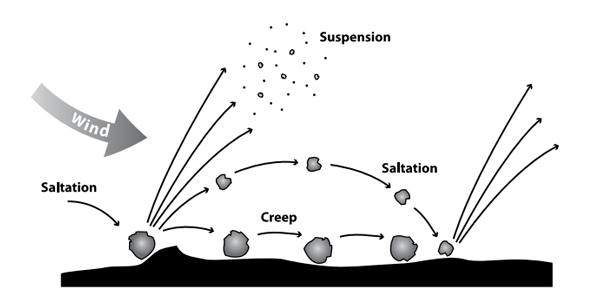Spring in Kansas means the potential for high winds. The critical wind erosion period is when agricultural fields are particularly vulnerable to wind erosion due to higher wind speeds than normal and low vegetative cover on fields. When high winds are coupled with dry conditions at the soil surface, even fields with crop residue may lose soil to wind erosion. It’s easy to see the dust blowing across the landscape, but it is not as simple to understand how the moving dust transports herbicides out of our fields.
After herbicides are applied, they are bound to soil particles. Herbicide molecules are adsorbed or bound by the finer fraction of soil particles (clay and organic matter). Also, the herbicide molecule's chemical properties help determine the extent of binding. Any herbicide that is bound to the soil necessarily goes along for the ride. There are three ways soil particles are moved by wind: surface creep, saltation, and suspension (Figure 1). Soil particles can become airborne with saltation or suspension. The smaller the particles, the more chance for detachment and airborne movement. Suspended soil particles form dust clouds that can travel large distances and cause visibility problems. This is the same fraction of soil that can be involved in off-target movement of herbicides.

Figure 1. Soil particles can move through saltation, creep, and suspension. Graphic from KSRE publication MF2860 Principles of Wind Erosion and its Control.
There isn’t a lot of research into the off-target movement of herbicides with wind erosion, and much of what exists is focused on the environmental fate of the herbicide. For example, how much does herbicide movement with wind-eroded soil contribute to herbicide deposition in places where it is not wanted, such as surface water bodies of susceptible crop fields? When herbicide losses have been measured as a percent of herbicide applied to the field, losses reported in the literature range from 1% of atrazine1 to 43% of simazine applied2. One study conducted in Alberta, Canada, concluded that wind erosion accounted for the disappearance of approximately 30% more herbicide than fields unaffected by wind erosion3. The same study reported that 2,4-D and other Group 4 herbicides were present at greater concentrations in windblown sediment compared to surface soil, while the concentration of the more volatile trifluralin (Treflan and others) was less in windblown sediment. More recently, scientists in South Dakota described the importance of a high surface area to volume ratio on the amount of herbicide lost when a soil particle is subject to wind erosion4.
What does this mean for fields affected by wind erosion? The fields in which weed control is most likely to be negatively affected by wind erosion are those that have finer-textured surface soil and were treated with a residual herbicide that has a longer half-life and/or is more tightly bound to the soil. Examples of such herbicides include atrazine, flumioxazin, sulfentrazone, S-metolachlor (Dual, others), and pyroxasulfone (Zidua, others). Herbicide persistence estimates can be found in the 2024 K-State Chemical Weed Control Guide at https://bookstore.ksre.ksu.edu/pubs/SRP1183.pdf.
If you think you may have lost a meaningful amount of treated soil from a field, consider scouting that field more frequently. Be prepared to make the next herbicide application sooner than expected. Including a residual herbicide in the sequential application may also be more important in these situations.
References:
1Glotfelty et al. 1989
2Gaynor & MacTavish 1981
3Larney et al. 1999
4Clay et al. 2001
Sarah Lancaster, Extension Weed Science Specialist
slancaster@ksu.edu
Jeanne Falk-Jones, Multi-County Agronomist
jfalkjones@ksu.edu
Jeremie Kouame, Weed Scientist – Agricultural Research Center, Hays
jkouame@ksu.edu
Deann Presley, Soil Management Specialist
deann@ksu.edu